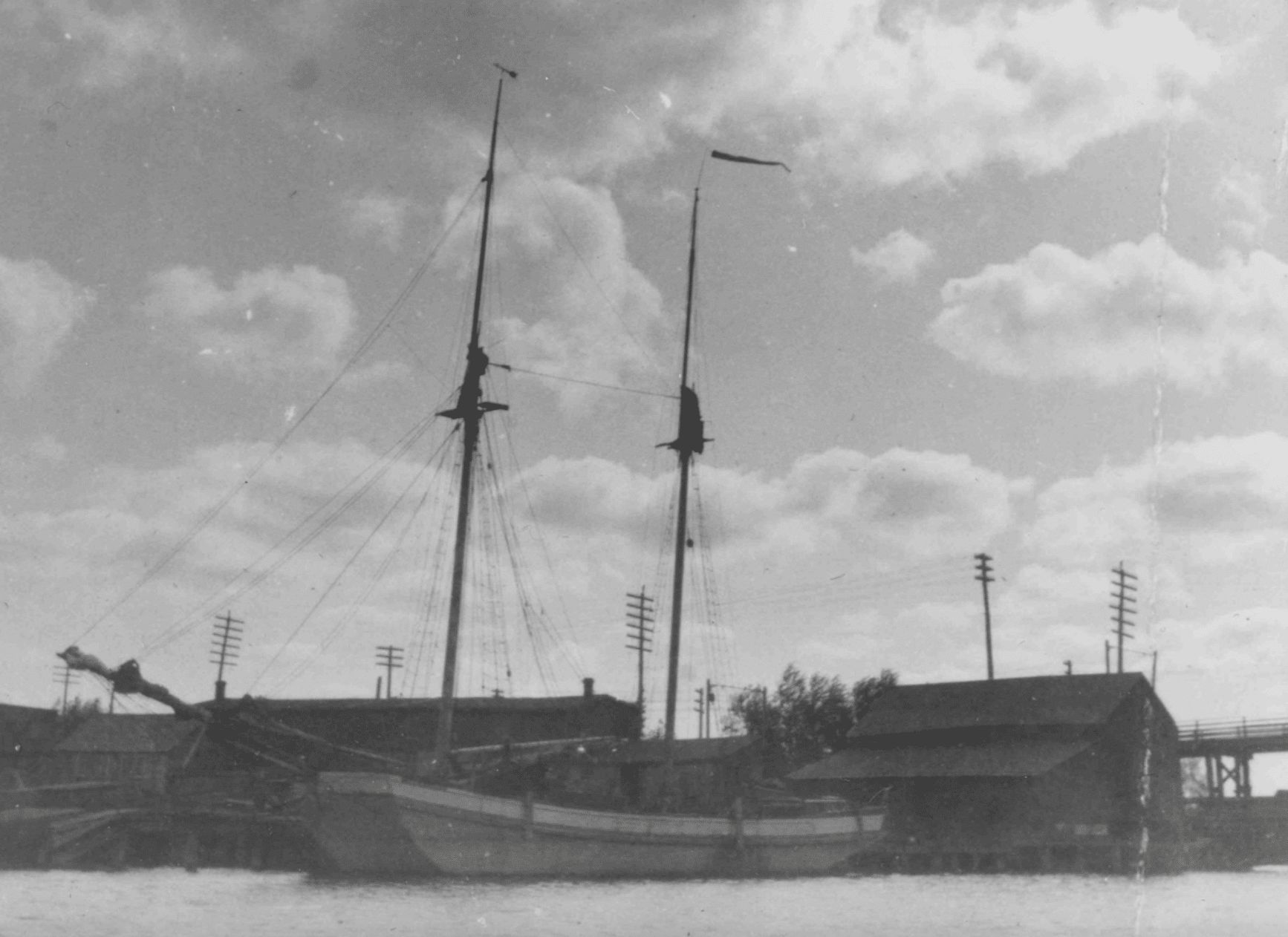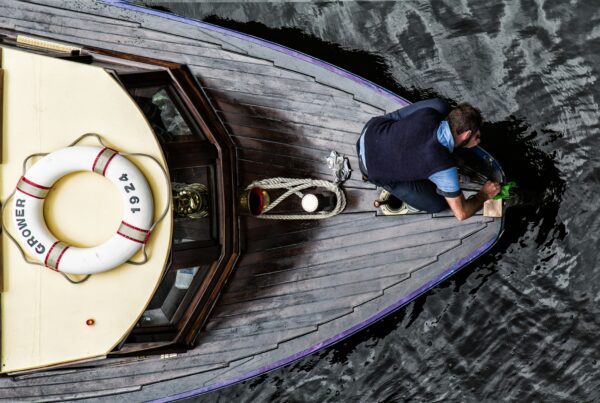Hi, I’m Tennie and Laura, but you can call me Tennie for short. I’m a scow schooner. I lived most of my life on the Great Lakes helping to increase the livelihoods of small towns and economies. My brethren and I were vital to small communities dotted along the Great Lakes, specifically Lake Michigan. As ships grew larger in the late 1800’s, so did their drafts. This meant many boats couldn’t stop at the smaller towns with shallow harbors.
Being a flat-bottomed scow I stepped in and became part of the lifeblood of immigrant families; giving people new to the country a chance to become part of the Great Lakes maritime trade. I not only provided hope to these immigrants but also a livelihood that was important for all of the Lake Michigan communities. In my day-to-day I carried an unknown number of homes and businesses in the form of lumber. I like to think this made an impact and that my services were integral to the economy and to spreading the cultures of various midwestern immigrants.
I was built in Manitowoc, Wisconsin 90 miles north of Milwaukee by Gunder Jorgensen in 1876. My build included just one deck with two masts and was 73 ft long with a 19 ft beam. I have had many owners over the years and have been scuttled all around Lake Michigan; Port Washington, Manitowoc, Chicago, and Benton Harbor are just a few places I called home.
I was a good sailor back in the day, and fast too. I was faster than conventional schooners, except in heavy seas where my wide, flat bow took a beating. Being a scow means that I have a specific hull shape; flat bottom, vertical sides, and a hard chine. I look more like a barge than an 1800’s sailboat. Us scows were not built to any plans, so there was always large variation between us. Sadly, insurance companies had little faith in my seaworthiness so most of us were assigned at most as a class B1.

On August 20th, 1901 John Sather of North Muskegon, Michigan bought me for what I later learned was $1,000 and became my sole owner and master. With Captain Sather, I made weekly trips from Muskegon to Milwaukee, mostly hauling lumber across the lake for two years.
I was 27 at the start of the 1903 season, and was very excited because Capt. Sather bought me new sails. I felt brand new, and couldn’t wait to feel the water push against my wide berth with the new cloth blowing in the summer winds. It was August 1st, and I had $500 worth of slab wood that I had picked up in Muskegon.
I normally had three people to take the trip back to Milwaukee, but Captain Sather’s son John asked for leave of the trip. We set off for Milwaukee shorthanded with Captain Sather’s only mate, Charles Nordbach at 10 am. At 6pm the sky began to darken and low, menacing storm clouds began to form over-head. The seas took a rough turn with what was building into gale-force-winds. I took a beating in the heavy seas and soon felt the cold lake michigan waters leaking through my planks.
Sather and Nordbach took turns between the wheel and pumping out the freshwater from my hull… but it was to no avail. The water inched upwards throughout the night. As the hours wore on, Sather and Norbach began to tire. I fought to stay upright for as long as possible, but the weight of the water eventually made me list. Limping along on the waves I tried my hardest not to buckle underneath them.
Soon after I began to list a large wave swept half of my load of lumber overboard, the cords of wood spilling into the deep, dark waters. I righted myself with a quick stop and stutter, where the remainder of the cargo washed over the other side, carrying away with it some of my hatch covers and deck planks.
I was mortally wounded.
The waves didn’t let up, the wind continued to howl. My hull was taking a beating as Sather and Nordbach tried with all their might to keep the wheel.
We went on like this for two more hours. At 5 am while we were just 10 miles northeast of Milwaukee another large wave hit us broadside and I couldn’t hold on any longer. With my masts inching towards the water and my starboard deck completely submerged, I let out a final groan as I capsized, belly up, giving into the seas.
As luck would have it, I didn’t sink right away thus allowing Sather and Nordbach to hold onto my hull as the winds carried us northward. Together we drifted for another hour and a half before the steamer “Mark B. Covell” spotted us en route to Milwaukee.

The Covell positioned itself as close to me as possible in the heavy seas and tossed a line to Nordbach, who by now was seated on the bow of my capsized hull. As he caught the line, I began to believe that all would be made well and that I could be saved along with my brave crew. Sadly, this hope was short-lived; as Nordbach and Sather slid off my shifting hull into the perilous sea Nordbach lost the line. Sather, however, maintained his grip and wrapped the line around his arm several times ensuring his safety as he was pulled onto the Covell.
I watched as the crew of the Covell threw a life preserver but Nordbach made no effort to retrieve it. A second line was thrown, dropping directly in front of his nose. I could see it on Nordbach’s face, he had nothing left; the cold, wet hours of fighting with wind and waves had taken their toll. Nordbach’s strength was gone and he made no attempt to grab the second line. I watched as he sank from sight, never to be seen again.
With the storm still prevailing and leaks abound with no crew, I gave into the sea as well. My remains can still be found here, nine miles southeast of Port Washington, Wisconsin. I sank a total of 325 feet, and as I hit the bottom of the lakebed I sank even further, nearly to my load line from the weight of my own impact. I somehow ended up staying upright and to this day one of my masts and rigging are still standing.
My stern cabin is missing but some of Sather’s items remain in its previous location, with a small stove, bucket of coal, and small cooking utensils splayed about. There is a large debris field off the starboard side of my bow where a mess of standing and running rigging stay. I have mussels who have colonized on my lines and rigging, but remnants of my white paint are still visible. Part of my name is still seen, on my port bow the word “Tennie” still legible.
I hear from the ROV dive crews that I am one of the best-preserved examples of a scow schooner, which is helpful as the techniques and rationale behind my construction and how I affected economies is still not well understood.
I’ve been here on the lakebed floor for 120 years now, but I hope that the ROV discoveries from the past couple of decades, and maybe more in the future, can help to shed light on the heavy work that we scow schooners provided for our owners throughout the 19th and even early 20th centuries.

We encourage you to use Port Gardner Yachts to connect with the rest of the boating community! Hop onto our Articles tab to read more content.




